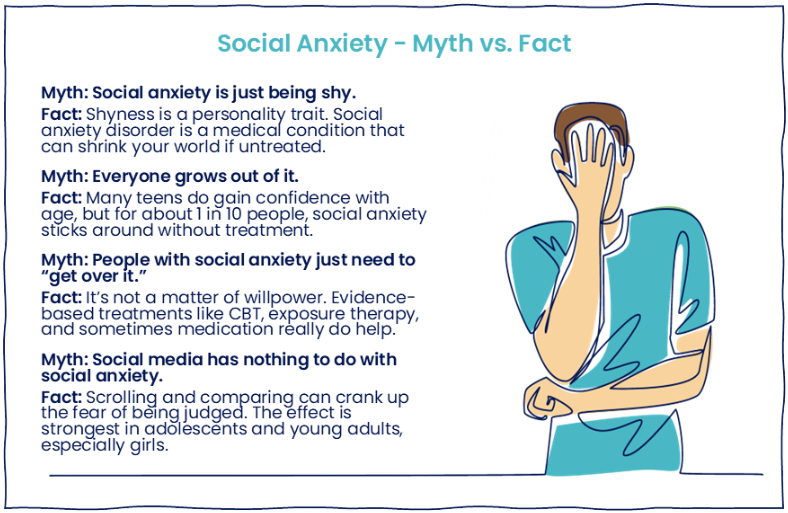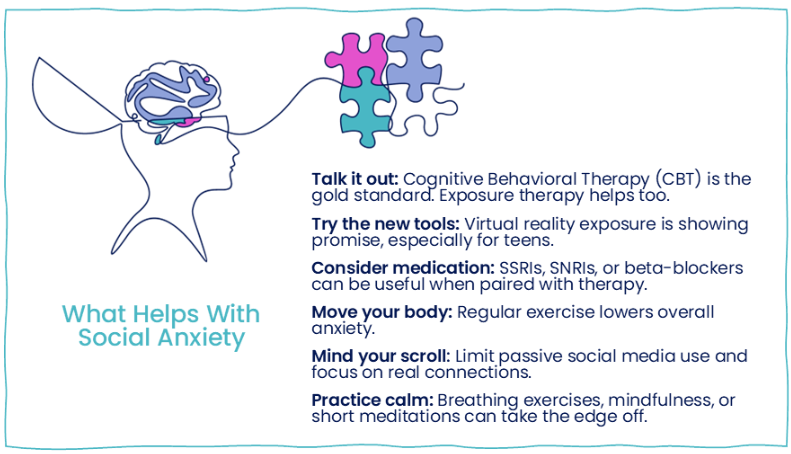
From Butterflies to Barriers:
What You Should Know About Social Anxiety
Social Anxiety — More Than Just Jitters
Meeting someone new, giving a presentation, or walking into a crowded room can make your stomach flip. We all feel nervous in social situations sometimes. That’s normal. But when those nerves become overwhelming, long-lasting, and start interfering with daily life, it’s something more. That’s when it becomes social anxiety disorder.
Feeling nervous before a big moment is part of being human. You might blush, sweat, or stumble over your words, but you bounce back once the event is over.
Social anxiety disorder is different. The fear of being judged or humiliated can last six months or more. It can trigger stronger physical symptoms like nausea, trembling, or a racing heart. It often leads to avoidance—skipping classes, work events, or even meals in public. Social anxiety disorder can limit our opportunities and chip away at our quality of life.
Social anxiety disorder is a psychiatric diagnosis determined by a medical provider after eliminating an underlying medical condition that could be causing symptoms. It is based on very specific criteria listed in the Diagnostic and Statistical Manual of Mental Disorders (DSM-5), published by the American Psychiatric Association, including:
- Persistent, intense fear or anxiety about specific social situations because you believe you may be judged negatively, embarrassed, or humiliated.
- Avoidance of anxiety-producing social situations or enduring them with intense fear or anxiety.
- Excessive anxiety that’s out of proportion to the situation.
- Anxiety or distress that interferes with your daily living.
- Fear or anxiety that is not better explained by a medical condition, medication, or substance abuse.
How common is it?
In the U.S., about seven percent of adults live with social anxiety disorder in any given year, and roughly twelve percent will experience it at some point in their lives. Among teenagers, about nine percent are affected, with some experiencing severe impairment. Adolescents and young adults, who are already navigating major social transitions, are most at risk for developing the disorder.
Girls are more likely to report social anxiety and are especially affected by appearance-based pressures and cyberbullying. Boys often have symptoms that are more tightly linked, meaning one symptom sets off others in a cascade. That can make episodes more intense, even if overall prevalence is lower.
That means that while nervousness is nearly universal, about one in ten people cross the line into a true disorder.

Why does it seem more common now?
Several forces are making social anxiety more visible and, in many cases, more common.
- Social media. Scrolling and comparing yourself to curated images or posts increases self-consciousness. Passive use is linked to higher anxiety, while active, genuine engagement is less harmful.
- Smartphones. They have made adolescence feel like a constant performance review. For girls and young women especially, the fear of negative evaluation online is a powerful driver of anxiety.
- Real increases. From 1990 to 2021, the incidence of anxiety disorders among people ages 10 to 24 rose by more than 50 percent worldwide, with sharp rises during and after the pandemic.
- Better recognition. Clinicians are screening more, parents are noticing symptoms earlier, and stigma around seeking help has declined.
Your health care provider will want to determine whether other conditions may be causing your anxiety or if you have social anxiety disorder along with another physical or mental health disorder.
Your health care provider may determine a diagnosis based on:
- Physical exam to help assess whether a medical condition or medication may be triggering symptoms of anxiety.
- Discussion of your symptoms, how often they occur, and in what situations.
- Review of a list of situations to see if they make you anxious.
- Self-report questionnaires about symptoms of social anxiety.
What helps?
The good news is that social anxiety disorder is treatable. Cognitive Behavioral Therapy (CBT) and exposure therapy are the most effective approaches. Virtual reality exposure therapy is an emerging tool, especially for teens. Medications such as SSRIs, SNRIs, or beta-blockers may be used alongside therapy.

Tips for Managing Everyday Social Anxiety
If you’ve read this far, you may have realized that your nerves, while uncomfortable, haven’t reached the level of a true social anxiety disorder. That doesn’t mean they are not worth addressing.
On a day-to-day level, exercise, mindfulness, and dialing back social media scrolling can all help manage symptoms. But there are some other practical approaches that can help you conquer most nerve-wracking social situations.
- Reframe your nerves. Feeling anxious before a party or presentation doesn’t mean you’re broken. A little anxiety sharpens focus and shows you care about the outcome. If you can imagine that you are experiencing symptoms of excitement, all the better.
- Prepare, don’t avoid. Plan a few conversation starters or practice your presentation. Preparation lowers uncertainty, which lowers anxiety.
- Breathe and ground yourself. Simple techniques like slow breathing, focusing on your senses, or a quick walk can calm racing thoughts before you step into a room.
- Start small. If big gatherings feel overwhelming, practice with smaller social exposures. A coffee with one person today makes the larger dinner easier tomorrow.
- Shift attention outward. Instead of worrying about how you look or sound, focus on the other person. Ask questions, really listen. Anxiety fades when you’re not monitoring yourself.
- Give yourself credit. You showed up. You participated. That’s a win, even if you still felt nervous.
The Bottom Line
Nervousness in social situations is normal and can be overcome with some planning and practice. But when social anxiety becomes persistent and limiting, it deserves attention.
Social anxiety disorder affects millions, especially in the smartphone era, but it is also highly treatable. A medical provider can help you determine whether you are experiencing “disorder-level” anxiety and what your best treatment options are.
For those of us experiencing more general social apprehension, best practices include preparation, deep breaths, visualizing success, and reframing those uncomfortable feelings. Thinking of your elevated heartrate, nervous stomach, and racing thoughts as excitement, rather than anxiety, can go a long way towards conquering your social jitters.